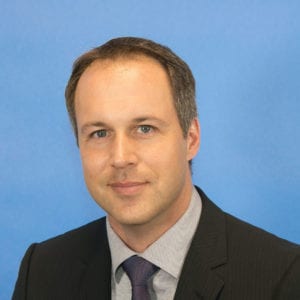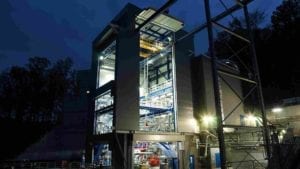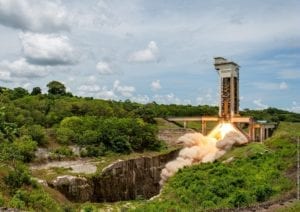
Europe’s prime launcher Ariane 5 is to retire in 2023, and the development of Ariane 6 is reaching a crucial stage. This week, the ESA Council will decide on additional budget that ESA requested to bring it to fruition.
SpaceWatch.Global Editor-in-Chief Markus Payer spoke to Daniel Neuenschwander, Director of Space Transportation at ESA, about Ariane 5 and 6, about the status of the projects and important market trends.
Markus Payer: Your most important work horse, Ariane 5, will retire in 2023. How many flights will we still see until then and how many flights will Ariane 5 have made in total when it retires?
Daniel Neuenschwander: Ariane 5 has eight launches ahead right now, amongst them the absolutely crucial James Webb Space Telescope that we should launch for NASA in October next year. This is in the category of a $10 billion project, and you can imagine what is at stake. But we will also have the European JUICE mission to study the planet’s icy moons. We will definitely come to the end of the exploitation of Ariane 5 early 2023. It will then have hopefully successfully launched 113 missions..
Ariane 6’s maiden flight has been pushed back to the second quarter of 2022. Why the delay?
We have, of course, a massive impact of Covid-19. This is certainly pushing us back on a number of topics. It’s clear, for example, that when your test site is closed, your project milestones slip. But I do not want to give the impression that everything is due to Covid-19. There were also technical issues, like with the cryogenic arm on the ground segment or the Auxiliary Power Unit (APU) on the launcher.
The delay causes an extra cost of 230 million Euros, you said. Did the ESA Member States approve this?

When we went to the ESA Council in October, we presented the situation in all transparency and put a proposal on the table. We aim at a decision in the December Council. We have not yet negotiated with the industry.
Do you expect the Member States to endorse your proposal?
I believe in things when they are signed, and don’t want to speculate. But I think we are in a good situation to present this decision, since we have successfully completed all engine tests. It is clear that we still have important challenges ahead of us, such as the hot firing test of the upper stage on the new test bench and then the combined tests. But it is the right moment to come up with our request and show the Member States that we are proceeding with the program. We are speaking about the biggest development project of ESA ever with unusual few margin. I’m looking forward to these discussions.
What exactly are the additional 230 million Euros for?
We’re asking for several elements. One element is that we have to modify parts of the launch pad, coming from the launcher, which was unforeseen. Then there were delays due to the shutdown of the Europe’s Spaceport in French Guiana, such as for the hot firing test on the second qualification model (QM2) of the P120C solid rocket motor. And then, we have also encountered some difficulties with the cryogenic arm, which are different for Ariane 6 because they will not retract before but with the lift-off. We have introduced this concept because it should lead to lower cost in operations.
What is the overall budget for the Ariane 6 program now? Is it 3.7 billion Euros plus 230 million?
That’s right, including P120C, common to Ariane 6 and Vega C. And since we are coming to the end of the program, the vast majority of the original amount is already spent.
Did the industry also invest in Ariane 6?
Indeed, the Ariane 6 program saw private investment of about 400 million Euros. You actually have to add this, on top of the 3.7 billion and the additional 230 million Euros. And I think that, at the end, the investment from industry will be higher.
Is this the end of the old school public funding concept? Is ESA looking for public-private partnerships and trying to turn the page?
I think it’s fair to say that the worldwide market has totally changed. We have a fierce competition with a significant drop in market prices. The biggest competition comes from U.S. launchers. But you should also see that the institutional prices in the U.S. have continuously increased over the past years. We cannot speak about a fair competition. ESA will propose a model for Europe in view of the next ESA Council at ministerial level, currently planned end 2022.
What can you do about it?

I think we have two important things to do. First of all, we have to ensure that we fly European consistently. We made a lot of progress on this topic in the last months and years, but we have to keep the pressure on. Second, we have to adapt our model, in order to be sustainable, and look for public as well as private funding commitments. We have started to go down that route. Ariane 6 already had private investment, as I told you. We have to find a new model, a new balance. I am pushing for a more demand-driven model in space transportation, and for further cost reductions in the industry but at the same time provide them a certain stability in production. We also have to think about new ways to incentivize the industry.
Is the lion share of private funding not going into new space, so that things are actually moving into the wrong direction and you cannot compensate the reduction of the European space budget with private investment?
We have opened the door to the commercial market and private investment with what we call commercial space transportation services. It’s not systems, it’s services. It’s not big amounts which are at stake today, but I think it is an important signal and eases further private investments. We will continue on this path.
Does this include rideshare? You have made a successful step into this growing market. Is it this what you call services?
I thank you for the question, because it allows me to say one key point. You can also address new markets with existing products. We demonstrated this with the Vega VV16 rideshare mission. 53 small satellites launched – it was quite challenging and kept my blood pressure up. But it demonstrated that we can take existing products and address new markets. Now we have to go one step further into fully commercially-led activities. We have to diversify, and we have to be versatile in delivering launch services and betting on the winning horse. And to come back to that point: I would be definitely interested to have more investors on board of upcoming ESA Space Transportation programs. We will see which orientation is given by the Member States , but I think that this commercial dimension will be an important aspect.
Is part of this equation also that Europe needs another small launch pad in the German North Sea or on a Norwegian island or in Scotland or somewhere else?
Access to space is fundamental for Europe’s autonomy of action in space. In 2019 European industry generated upstream revenues of nearly 9 billion Euros and downstream revenues around 70 billion Euros. For this, you have to have all systems working, we need autonomous access to space. We can achieve a major part through our European spaceport in French Guiana. French Guiana has amazing advantages. You can launch to the North, you can launch to the East, you’re immediately over the sea, you don’t have earthquakes, and you have rather stable climatic conditions. We have all with our European spaceport. However, we should also be very open to new activities and welcome the development of European ground infrastructure activities. I only do not see why we should diversify in the field of test ranges and not capitalize on what we have. A test bench is something which should be optimized and centralized at a European level.
How does the Ariane 6 order book look like? Any chances to announce a passenger for the maiden flight, since you lost OneWeb?
We have a manifest of 14 launches for the transition to Ariane 6. We have some open positions, but we also already have a number of customers, mostly institutional. Like Galileo. We are quite advanced, but I am a bit cautious to disclose names right now because it depends on the readiness of the payload, but also of the launch system.
SpaceWatch.Global thanks Daniel Neuenschwander of ESA for the interview.





